Antarctic Krill
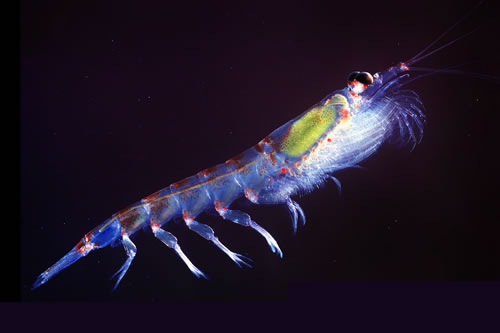
Antarctic krill is a species of krill found in the Antarctic waters of the Southern Ocean. Antarctic krill are shrimp-like invertebrates or crustaceans that live in large schools, called swarms, sometimes reaching densities of 10,000-30,000 individual animals per cubic meter. They feed directly on minute phytoplankton, thereby using the primary production energy that the phytoplankton originally derived from the sun in order to sustain their pelagic (open ocean) life cycle. They grow to a length of 6 cm (2.4 in), weigh up to 2 g (0.7 oz), and can live for up to six years. They are a key species in the Antarctic ecosystem and are, in terms of biomass, probably the most successful animal species on the planet (approximately 500 million tonnes).
Arctic Tern
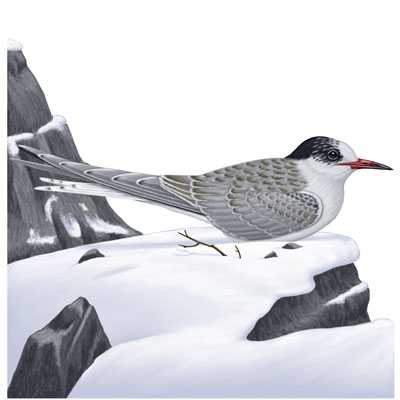
The Arctic Tern is a seabird of the tern family Sternidae. This bird has a circumpolar distribution, breeding colonially in Arctic and sub-Arctic regions of Europe, Asia, and North America (as far south as Brittany and Massachusetts). The species is strongly migratory, seeing two summers each year as it migrates from its northern breeding grounds to the oceans around Antarctica and back (about 24,000 miles) each year. This is the longest regular migration by any known animal. The arctic tern flies as well as glides through the air, performing almost all of its tasks in the air. The arctic tern lands once every one to three years (depending on their mating cycle) to nest; once they have finished nesting they take to the sky for another long southern migration.
Arctic Terns are medium-sized birds. They have a length of 33-39 cm (13-15 in) and a wingspan of 76–85 cm (26-30 in). They are mainly grey and white plumaged, with a red beak (as long as the head, straight, with pronounced gonys) and feet, white forehead, a black nape and crown (streaked white), and white cheeks. The grey mantle is 305 mm, and the scapulars are fringed brown, some tipped white. The upper wing is grey with a white leading edge, and the collar is completely white, as is the rump. The deeply forked tail is whitish, with grey outer webs. The hindcrown to the ear-coverts is black.
Arctic Terns are long-lived birds, with many reaching thirty years of age. They eat mainly fish and small marine invertebrates. The species is abundant, with an estimated one million individuals. While the trend in the number of individuals in the species as a whole is not known, exploitation in the past has reduced this bird's numbers in the southern reaches of its range.
Emperor Penguin
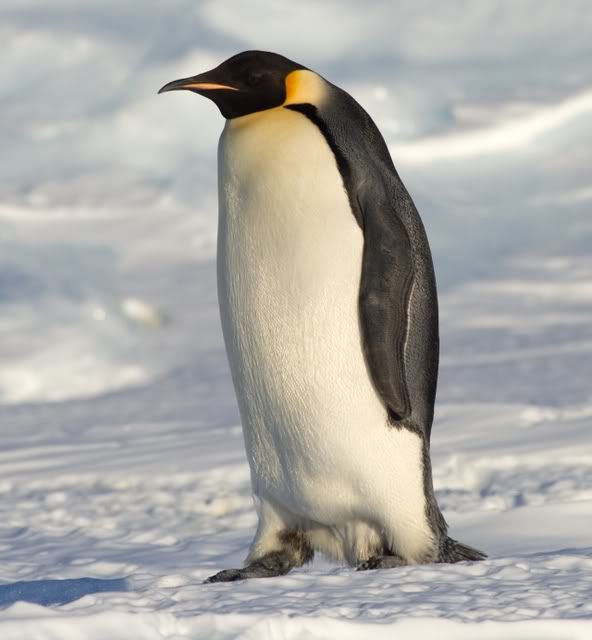
he Emperor Penguin is the tallest and heaviest of all living penguin species and is endemic to Antarctica. The male and female are similar in plumage and size, reaching 122 cm (48 in) in height and weighing anywhere from 22-37 kg (48-82 lb). The dorsal parts are black and sharply delineated from the white belly, pale-yellow breast and bright-yellow ear patches. Like all penguins, it is flightless, with a streamlined body and wings stiffened and flattened into flippers for a marine lifestyle.
Fish form the bulk of its diet, which can include crustaceans, such as krill, and cephalopods, such as squid. In hunting, the species can remain submerged up to 18 minutes, diving to a depth of 535 m (1,755 ft). It has several adaptations to facilitate this, including an unusually structured haemoglobin to allow it to function at low oxygen levels, solid bones to reduce barotrauma, and the ability to reduce its metabolism and shut down non-essential organ functions.
The Emperor Penguin is perhaps best known for the sequence of journeys adults make each year in order to mate and to feed their offspring. The only penguin species that breeds during the Antarctic winter, it treks 50–120 km (31-75 mi) over the ice to breeding colonies which may include thousands of individuals. The female lays a single egg, which is incubated by the male while the female returns to the sea to forage; parents subsequently take turns foraging at sea and caring for their chick in the colony. The lifespan is typically 20 years in the wild, although observations suggest that some individuals may live to 50 years of age.
Penguin
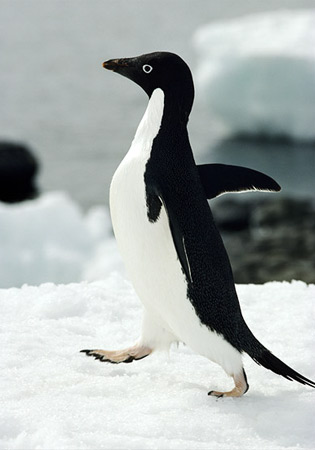
Penguins are a group of aquatic, flightless birds living almost exclusively in the Southern Hemisphere. Highly adapted for life in the water, penguins have countershaded dark and white plumage, and their wings have become flippers. Most penguins feed on krill, fish, squid, and other forms of sealife caught while swimming underwater. They spend about half of their life on land and half in the oceans.
Although all penguin species are native to the southern hemisphere, they are not found only in cold climates, such as Antarctica. In fact, only a few species of penguin live so far south. Several species are found in the temperate zone, and one species, the Galapagos Penguin, lives near the equator.
The largest living species is the Emperor Penguin (Aptenodytes forsteri): adults average about 1.1 m (3 ft 7 in) tall and weigh 35 kg (75 lb) or more. The smallest penguin species is the Little Blue Penguin (also known as the Fairy Penguin), which stands around 40 cm tall (16 in) and weighs 1 kg (2.2 lb). Among extant penguins larger penguins inhabit colder regions, while smaller penguins are generally found in temperate or even tropical climates (see also Bergmann's Rule). Some prehistoric species attained enormous sizes, becoming as tall or as heavy as an adult human (see below for more). These were not restricted to Antarctic regions; on the contrary, subantarctic regions harboured high diversity, and at least one giant penguin occurred in a region not quite 2,000 km south of the Equator 35 mya, in a climate decidedly warmer than today.
Penguins seem to have no special fear of humans and have approached groups of explorers without hesitation. This is probably because penguins have no land predators in Antarctica or the nearby offshore islands. Instead, penguins are at risk at sea from predators such as the leopard seal. Typically, penguins do not approach closer than about 3 meters (10 ft) at which point they become nervous. This is also the distance that Antarctic tourists are told to keep from penguins (tourists are not supposed to approach closer than 3 meters, but are not expected to withdraw if the penguins come closer).
Weddell Seal
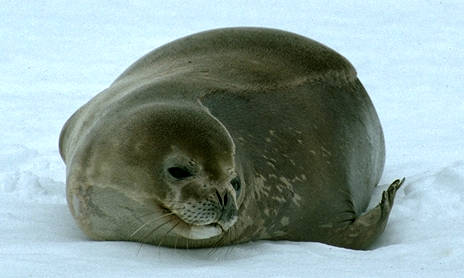
The Weddell Seal (Leptonychotes weddellii), is a true seal that occurs in large numbers and inhabits the circumpolar region of the southern hemisphere, including Antarctica. It is estimated that there are approximately 800,000 individuals today. It can regularly be seen in the many seasonally ice-free islands along the Antarctic Peninsula. This pinniped is not thought to migrate, and any local movements are usually the result of changes in ice conditions.
The Weddell seal was named and discovered by a British sealing captain, James Weddell in the 1820s when he was on a sailing expedition within the Weddell sea, also named after James Weddell. . It is the only species in the genus Leptonychotes





